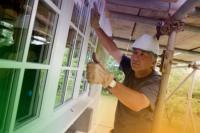Simply explained, double glazing works on the principle that air, or gas is not nearly as good of heat conductor as materials such as glass.
So, double glazing is made up of two panes of glass with a central area filled with inert gas.
This layer does not conduct heat very well and so significantly limits the amount of heat that actually escapes through the window and outside of the home.
This means in winter a double glazed window will keep your home insulated and is far more useful than a single pane.
Types of Double Glazing Explained
Most double glazing installed in the UK is uPVC and there are lots of benefits to this sort of window frame.
UPVC is very durable and easy to maintain, and does not need painting or varnishing every few years.
UPVC can also be cheaper than other materials such as wood or aluminium, and modern production techniques means that uPVC windows don’t have to be white as they can be produced in any number of shades.
Wooden double glazed units may be the only option if you live in a listed building or in a conservation area, and although they require more maintenance than uPVC, they are more attractive and look more at home on a period property.
Wooden double glazing is also very durable if looked after properly, and can easily last as long as uPVC frames.
The third type of window frames are aluminium, which can be more expensive than uPVC, but the frames are often thinner which may be preferable depending on the design.
Most companies offer several different types of window frames.
Rating Schemes with Windows and Glazing
When we are spending a lot of money on a product, we want to have some sort of guarantee that it is going to do what the manufacturers claim.
Few of us have the in depth technical knowledge to compare one set of double glazed windows against another, and for this reason the government has introduced a simple rating system which should help the man in the street see which windows offer them the best value for money.
Window Energy Rating System
Here in the UK, our double glazed window energy rating system is part of a wider European system which rates everything from dishwashers to cookers.
The window rating system follows the same A-G scale as your washing machines, with each letter within the scale having a different colour too.
Any product, including double glazed window units which have an A rating are the most energy efficient available.
Other double glazed units which are rated B or C are less efficient, but still better than old fashioned single glazed units which will be at F or G on the scale.
The scale is designed to be simple to use, but if customers still have questions about the scheme, the body which awards the ratings in the UK is the BFRC (British Fenestration Ratings Council).
Taking ratings into account when buying double glazed windows
There is always a balancing act which needs to be done between the additional price you pay for A grade rated windows and the additional cost savings you can expect to get when compared with B or C rated windows.
The difference in savings between A and C rated double glazed units is around £75 a year for the average home, so over the 20 year lifespan of your double glazing, this can make quite a difference financially.
Manufacturers and window sales companies should be open about the rating which their windows have achieved, and it’s definitely one of the factors which you should be taking into account when comparing different quotes.
How much does the rating scheme affect costs?
It would be reasonable to expect that more highly rated double glazing will cost more than lower rated glazing, and this is often the case.
However, there are usually deals to be done or promotions to be taken advantage of, and it’s important to shop around and get at least three written quotes from double glazing companies you have found through personal recommendation or on Top Tradespeople.
Make sure you are clear about the energy rating of the windows as well as the overall cost, including fitting and VAT. The average price for double glazing a standard three bed semi is around £7000, but if your windows are particularly large, you will pay more.
Depending on the state of your current windows, you may be eligible for funding through the government’s Green Deal scheme which allows you to spread the cost of installing energy savings measures, and pay back the cost over a fixed term through your energy bills.
 With rapidly rising gas and electricity bills, it’s no wonder that more of us than ever are looking at ways of reducing the amount of energy we use.
With rapidly rising gas and electricity bills, it’s no wonder that more of us than ever are looking at ways of reducing the amount of energy we use.
Double glazing is one of the best ways to insulate your home and keep the draughts out, and as well as reducing your spend on fuel, it will add value to your property.
There are many different types and styles of glazing, and these sorts of windows don’t have to mean white plastic uPVC frames.
Once you have an idea of the sort you are looking for, Top Tradespeople can help you find experienced and reputable companies in your local area to approach for quotes.
Cost Savings of Double Glazing
It’s difficult to give exact figures about how much you will save as a lot depends on the amount you are spending on energy to start with, and how big your house is.
However, experts reckon that you could save between £90 and £120 on your fuel bill every year by installing double glazing.
As the average lifespan of this material is 20 years or more, you can easily save over £2,000 during the lifetime of your windows.
Savings will be increased further if at the same time as installing double glazing you also undertake other energy efficiency measures such as cavity wall insulation or loft insulation.
Prices for Double Glazing Explained
Companies generally prefer to replace all the windows in a house, or at least all of the windows on one floor rather than doing small jobs of one window at a time.
Count up the number of windows you have in your house and measure them.
Look to Top Tradespeople for the contact details of double glazing firms in your local area, and choose some to contact for a quote.
A company representative will usually come to visit and accurately measure your windows, and discuss different styles and options for things like handles and coloured glass with you before giving you a final price.
As a rough guide, the average price for 12 windows in a 3 bedroom semi is about £5,500, and the average price for a uPVC door is about £600.
If you have particularly large “picture” windows or have specified patterned glass, lead lighting or other extras you can expect the cost to be more.
Paying for Double Glazing
Double glazing isn’t cheap, but as well as cutting your fuel bills it will add to the value of your home and make it more secure too.
Home improvement loans are available from many banks and building societies to meet the cost of glazing, and in some areas you may be entitled to government grants to help towards the cost.
Many of the larger double glazing firms also offer deals such as zero percent finance, and this can be a very good way of spreading the cost over several years.
Most reputable companies will also give several years’ guarantee on your new windows, so you shouldn’t face any unexpected repair or maintenance bills in the first few years of owning them.
Always make sure you get quotes from at least three local double glazing companies to allow you to compare the various prices and offers.
Installing Double Glazing
Once the salesperson has measured up your windows, they will be specially built in the factory to fit your home.
This can take a couple of weeks, but the salesperson will be able to give an indication of when you can expect to have the windows fitted when you confirm the order.
Glazing of this type can be fitted in the average home in a day, which minimises disruption and mess. If your home is larger than average, it might take longer.
The Science
To be more scientific, warm molecules move faster than cold ones.
When one warm molecule bumps into another next to it, it shakes it and it starts moving equally as quickly.
This continues and all the molecules begin to move faster and so conduct heat.
Glass's molecules tend to be very close together and so conduct heat quickly.
Air's molecules are further apart and so don't tend to conduct materials nearly as quickly.
To put it in more simple terms, the woolly jumper you wear is very similar.
As the fibres of these jumpers trap air between them and also the warm molecules coming from your body.
Wool jumpers slow down the molecules and form an insulated layer between your body and the outside world and so keep your body warm.
Argon
Many of the double glazing windows don't actually have air between them, they in fact have a gas called argon.
This gas is inert and doesn't react with other materials and is a third poorer of a conductor than air.
This increases how hard it is for heat to escape through the window, even more so.
Getting the difference between the inside and the outside of the pane is important.
Panes that are too close together will transfer heat across either pane, whereas panes too far apart also cause problems.
These panes have significant temperature differences and cause the air between panes to move around.
This can allow heat to escape from one side to the other.
The optimum width between the panes is 16mm - 19mm.
The Frame
These glass panes are placed between either wood, aluminium, or uPVC panels, though this is also to be considered.
Aluminium is light and strong, however it also is a conductor of heat meaning an insulation has to be placed between it and the pane.
Wood can also be used and is a great insulator, however it is manmade and can really wear with time.
UPVC frames are probably the best as they are both good insulators and also hard wearing.
This makes them among the most popular choices for UK buyers as they offer the best of both worlds for those looking to use double glazing on their homes.








